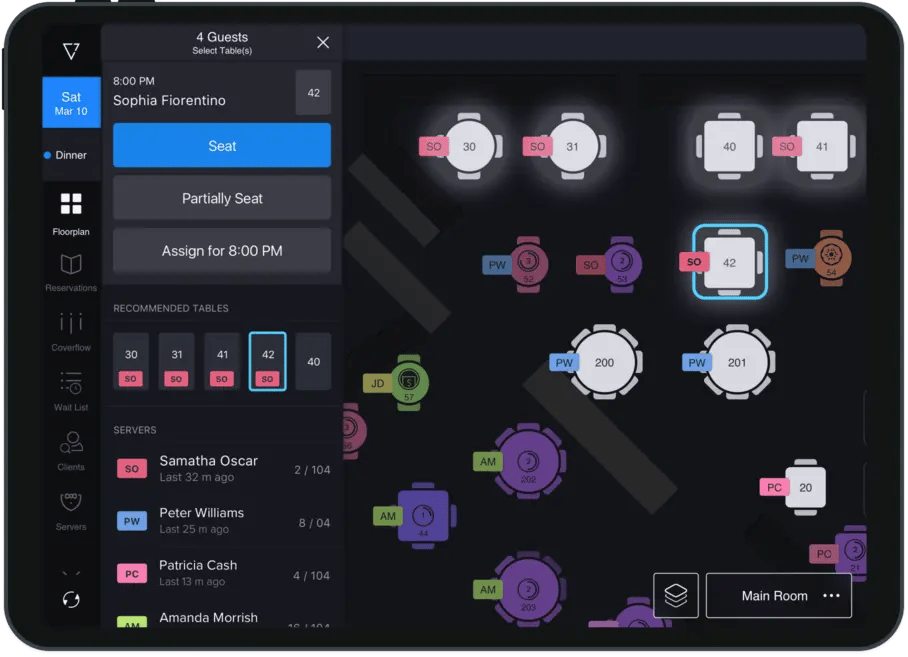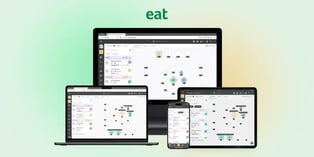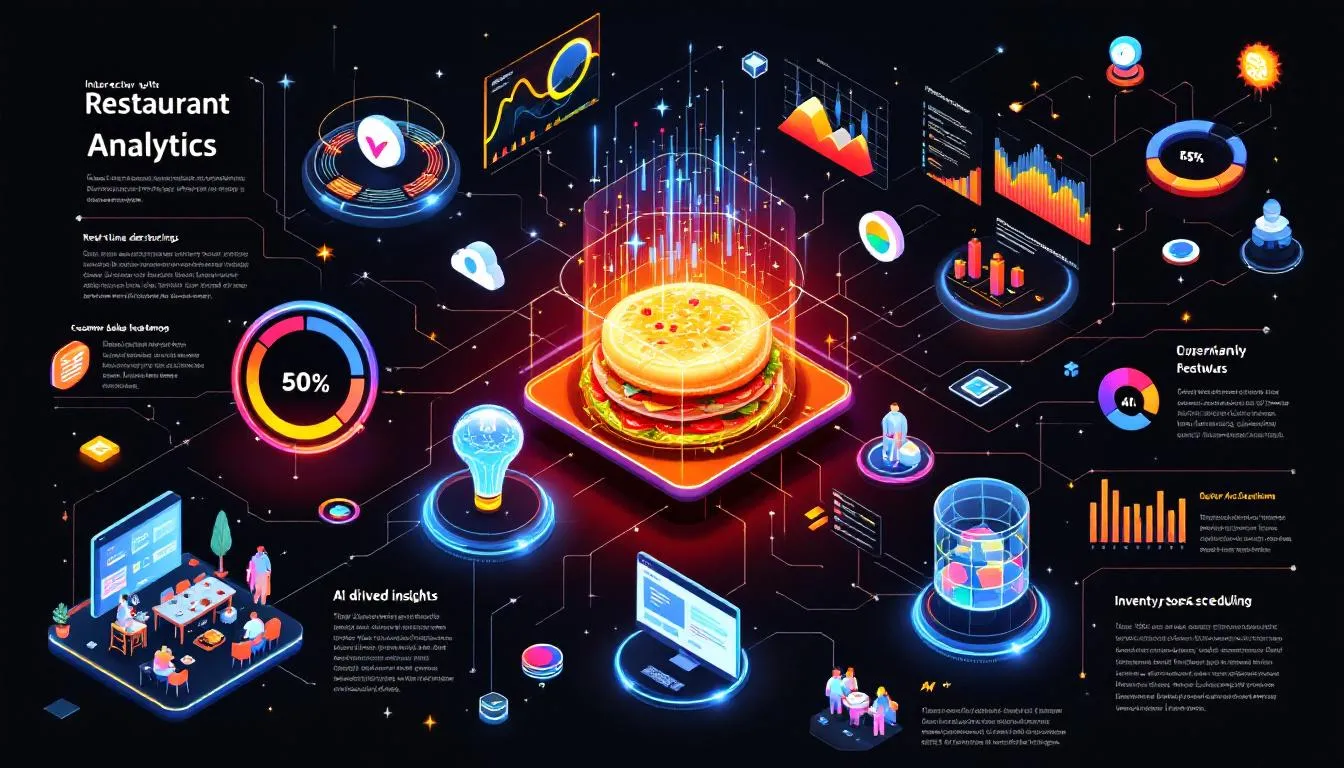TheFork (a TripAdvisor subsidiary) is known for its broad diner network and easy online booking tools. However, it may not be the perfect fit for every restaurant. Many venues find TheFork’s per-cover commission fees and limited CRM features challenging. If you’re looking for a better solution whether due to pricing, flexibility or more advanced capabilities this list of top TheFork alternatives and competitors will guide you to the best options.
If you're considering switching, this guide will help you choose the best the fork alternative for your business needs.
From local bistros to Michelin-starred restaurants, every business needs software that streamlines reservations, reduces no-shows and builds guest relationships. Below are several TheFork competitors, each offering a fresh take on table bookings, guest management or marketing to help your restaurant thrive.
Eat App

Eat App offers online reservations, waitlist management and table layout tools, all built to boost efficiency. As a TheFork competitor, it’s a strong alternative for restaurants seeking more flexibility and value, especially with no per-cover fees and rich guest CRM capabilities.
Key Features:
-
Real-time floor plan & table management: Interactive table layouts and status updates to optimize seating.
-
Built-in CRM with loyalty tagging: Track guest profiles, preferences and visit history to personalize service.
-
Multi-channel booking & communication: Accept reservations via website, Google and send confirmations or promotions via SMS, WhatsApp and email.
-
Waitlist with live updates: Handle walk-ins alongside reservations with automatic waitlist notifications.
-
Commission-free pricing: No per-cover or ticketing fees, unlike TheFork’s commission model
Eat App supports both traditional reservations and walk-ins, making it a compelling TheFork alternative for everyday bookings or special events. It’s trusted by over 6,000 restaurants globally and many report it makes tracking regulars and their preferences much easier.
Pricing Plans:
-
Free Plan: $0/month: Up to 30 covers each month (great for trying out the system).
-
Starter Plan: $69/month: Up to 300 covers per month.
-
Basic Plan: $139/month: Unlimited covers each month.
-
Pro Plan: $239/month: Full suite of advanced guest experience tools included.
Takeaway: Eat App is a comprehensive, cost-effective reservation solution for restaurants that want full control without high cover fees. It combines reservations, waitlisting and guest engagement in one platform, expanding reach and reducing no-shows for its users.
Take a look at the pricing plans here.
OpenTable

OpenTable is a well-known name among TheFork competitors, providing access to millions of diners through its popular consumer app. It’s an ideal site like TheFork for boosting your restaurant’s discoverability beyond TripAdvisor. OpenTable’s network and marketing reach can help fill your tables consistently. Key highlights include:
-
Massive diner network: Exposure to OpenTable’s large user base can drive new guests to your restaurant.
-
Integration with Google and POS systems: Supports Reserve with Google and connects with many point-of-sale systems for a seamless operation.
-
Waitlist and review management: Tools for managing waitlists and responding to diner reviews, helping maintain your reputation.
OpenTable is a powerful platform for attracting diners, but be prepared for extra costs per reservation. The platform charges per-cover booking fees that can add up quickly. (Remember, with OpenTable you pay for each guest booked, whereas other systems like Eat App don’t charge per cover)
Pricing:
- Basic plan: $39/month (with ~$1.50 per cover via OpenTable + $0.25 via widget)
- Core plan: $249/month ( ~$1 per cover)
- Pro plan: $449/month (also ~$1 per cover), These fees are in addition to the monthly rate, so costs can grow as reservations increase.
Further reading
Resy

Resy provides sleek guest management tools with a focus on hospitality-driven service. It integrates with American Express, giving it strong reach among premium diners and helping VIPs feel valued. As a TheFork alternative, Resy shines by avoiding per-cover fees in favor of flat monthly pricing, making costs predictable.
Standout Features:
-
Personalized guest profiles & tags: Restaurants can tag guests (e.g. VIP, allergies) and access shared profiles across the Resy network, enhancing service.
-
Multiple booking channels: Accept reservations via your website, Instagram, Google and even the Amex app increasing your visibility to high-end customers.
-
2-way SMS communication (optional): Communicate with guests via text for confirmations or special requests.
-
Custom floor plans and widgets: Interactive floor plan management and embeddable web widgets for direct online bookings.
Resy is a TheFork competitor that values branding and white-glove service. It’s widely used in the U.S. and has a growing global presence, though its diner network is strongest in North America. If you prioritize a refined guest experience and flat monthly pricing over marketplace exposure, Resy is a solid choice. Keep in mind it’s primarily US-focused in terms of network and support
Pricing:
Resy’s plans are tiered by feature level.
- Basic: $249/month
- Pro: $399/month
- Enterprise: $899/month, with no per-cover commissions.
All plans give full access to its reservation and table management system.
Sevenrooms

SevenRooms is designed to deliver highly tailored guest experiences. As a TheFork competitor, SevenRooms goes beyond basic bookings, it’s as much a hospitality CRM and marketing platform as a reservation system. This makes it popular with restaurants that want to build deeper loyalty or run sophisticated campaigns.
Notable Features:
-
Rich guest profiles: Track detailed visit history, preferences and even spend, enabling truly personalized service for repeat guests.
-
Automated marketing & campaigns: Create custom email campaigns and re-engagement flows directly from the system to turn first-time diners into regulars.
-
Event ticketing and prepayments: Supports deposits or ticketed events (tasting menus, pop-ups) to secure revenue and reduce no-shows, similar to TheFork’s event tools, but more flexible.
-
Integration ecosystem: Connects with POS, loyalty programs and other systems to centralize your data.
SevenRooms is an attractive analog to TheFork for restaurants that need robust guest data and marketing tools alongside reservations. It’s used globally, especially by upscale venues. However, this power comes with complexity the tool can feel complicated and pricey for smaller teams. Training is often required and setup can be more involved than lighter systems.
Did you know?
Did you know? Eat App offers a built-in loyalty suite and two-way WhatsApp messaging with guests, plus a 3D floor plan view and it’s more affordable and easier to use than SevenRooms. Many restaurants find they can get similar benefits with a gentler learning curve by choosing the right SevenRooms alternative.
Yelp Guest Manager

Yelp Guest Manager (formerly Yelp Reservations) combines reservation and waitlist management with the consumer visibility of Yelp. It’s a practical TheFork competitor for restaurants that rely on Yelp’s massive user base, especially in North America. By being integrated with Yelp, it helps turn the platform’s high-intent diners into bookings.
Key Benefits:
-
Integrated with Yelp listings: Your Yelp page doubles as a booking channel, diners can book directly while reading reviews of your restaurant. Great for capturing interested visitors on Yelp.
-
Real-time notifications & table updates: The system provides live updates to staff (and optionally to guests via text) about waitlist status and table turnover.
-
Flat monthly pricing: Unlike TheFork, Yelp Guest Manager uses a subscription model with no per-cover fees, which can save money as you seat more guests.
This is a solid analog to TheFork if you already get significant traffic from Yelp or prioritize local discovery. It may not have all the advanced CRM bells and whistles of some competitors (for instance, Eat App’s built-in CRM is more robust), but it excels in boosting online visibility and is fairly budget-friendly for small to mid-size restaurants.
Pricing:
- Basic: $129/month, including online reservations via Yelp, Google, and Apple Maps (up to ~500 covers/month) plus two-way texting and other core features.
- Plus: $279/month, which offers unlimited covers, POS integration, a VIP guestbook, and other enhancements. There are no additional cover fees on top of these monthly rates, a key difference from TheFork’s commission structure.
Further reading
TableIn

TableIn is designed for independent restaurants and small teams. It provides the essential reservation and guest tracking tools with a minimal learning curve. If TheFork feels too complex or costly for your needs, TableIn is a similar website to TheFork that keeps things simple and affordable.
Why it’s a good fit:
-
Affordable monthly plans: TableIn’s pricing is budget-friendly for small restaurants, with tiers that scale as you grow.
-
Social media booking widgets: Easy integration of reservation widgets on Facebook/Instagram, so diners can book directly through your social pages.
-
Email/SMS confirmations: Automated confirmations and reminders via email or text help reduce no-shows, without needing expensive add-ons.
TableIn is a good site like TheFork for businesses that want simplicity and control without added complexity. The interface is clean and straightforward, making it easy for non-technical staff to adopt. Restaurants can quickly set up their floor plan and start taking online bookings without extensive training.
Pricing Plans:
- Basic: $99/month (supports ~315 reservations per month), suitable for smaller venues.
- Pro: $149/month and offers unlimited reservations each month. All plans include core features, you choose the tier based on your volume.
ResDiary

ResDiary is a flexible TheFork alternative popular in the UK and Europe. It offers tools to handle everything from everyday bookings to special events, with a strong focus on transparent pricing and customization. For restaurants looking to avoid surprise fees, ResDiary’s flat pricing (no per-cover fees) is a big draw.
Key Advantages:
-
Flat monthly pricing: No commission per cover, you pay a fixed monthly fee for unlimited bookings, which can be more predictable than TheFork’s commission model.
-
Phone booking automation (ResPhone): An automated telephone reservations system that can take bookings and cancellations via phone, reducing staff workload.
-
Supports deposits and no-show policies: Built-in ability to take card details or deposits for reservations and enforce cancellation policies, helping to reduce no-shows.
ResDiary is an attractive TheFork competitor in Europe and beyond, known for its reliable support and feature set. It helps reduce no-shows with automated email/SMS reminders and easy deposit handling, ensuring your tables are occupied by committed guests.
Pricing: ResDiary often prices in local currency. A typical structure in the UK is:
- Connect at £99/month
- Express at £129/month
- Pro at £189/month
- Ultimate at £289/month, with all plans offering unlimited bookings.
Further reading
Quandoo

Quandoo is another strong the fork alternative, especially for European or APAC restaurants wanting both direct reservation tools and exposure on a large diner marketplace. It offers a blend of direct website bookings and third-party discovery.
It’s ideal for operators seeking to boost visibility across regions without losing control of their own reservations. While marketplace bookings incur fees, widget-based bookings are commission-free.
Platform features include:
-
Integrated booking widget: A widget for your website and social media that feeds bookings into Quandoo’s system, so all reservations are managed in one place.
-
AI-powered wait time estimates: Quandoo uses AI to predict wait times for walk-ins or next available tables, helping manage guest expectations.
-
Regional diner marketplace: Your restaurant can be discovered by users on Quandoo’s consumer app/site, similar to how diners find places on TheFork or OpenTable’s marketplaces. This can drive new customers searching in your area.
Quandoo is well-suited for restaurants looking to increase reach in Europe or APAC markets. By listing on its marketplace, you tap into an additional diner base (although smaller than TheFork’s network). The trade-off is that for reservations originating from the marketplace, Quandoo charges a commission. Bookings made through your own channels (your website or social pages via the widget) are typically fee-free.
Pricing:
- Pro: £39/month
- Premium: £99/month have been reported.
- In addition, Quandoo may charge about £3.90 per guest for reservations that come through its marketplace/app.
Reservations made via your own website using their tools don’t incur this fee. Always check the latest pricing details with Quandoo, as they may change their commission rates or offer custom packages.
Further reading
Tock

Tock is perfect for restaurants that rely on prepaid reservations, prix-fixe menus and ticketed experiences. It's a premium the fork alternative when looking for more control over revenue through prepayment and deposits.
Tock stands out with its unique combination of event ticketing, upsell opportunities (like wine pairings or add-ons) and customizable experiences. Its structured pricing helps reduce no-shows while elevating the overall guest journey.
Key Highlights:
-
Prepaid reservations & deposits: Tock allows you to charge diners upfront (or take a deposit) for reservations. This dramatically reduces no-shows and is ideal for high-end tasting menus or events – something TheFork also supports, but Tock specializes in it.
-
Event and tour management: Create and sell tickets for special events, chef’s table experiences or even restaurant tours. Tock was built with these scenarios in mind.
-
Robust table management: An optimized floor plan system helps maximize seating efficiency and revenue, similar to other top systems
-
Guest surveys and loyalty: Option to send post-dining surveys and gather feedback. Tock also provides tools to identify regulars and VIPs contributing to a light CRM capability.
If you run a restaurant that frequently does ticketed events, prix fixe dinners, or just want to eliminate no-shows via prepayment, Tock is a compelling alternative. It gives you extensive control over the reservation process (you can even set up variable pricing for peak times or special experiences). The platform has a loyal following among innovative restaurants and was acquired by Squarespace indicating continued investment in its development.
Pricing:
- Plus: $249/month (which charges a 2% fee on prepaid reservations)
- Pro: $749/month (no fee on prepaid reservations) Both plans give full feature access, the difference is whether you’re sharing revenue on those prepaid experiences.
- An Enterprise plan is also available for large groups or institutions (pricing on contact) Note that Tock does not charge per-cover fees for regular reservations, only the percentage on prepaid tickets for the Plus tier. So if your restaurant doesn’t do prepaid events, the costs are essentially flat monthly.
TableAgent
.png?width=427&height=118&name=download%20(2).png)
TableAgent is the go-to the fork alternative for small restaurants that want a free, no-frills reservation platform. It's designed for operators who need simple booking functionality without advanced CRM or marketing tools.
It’s ideal for pop-ups, food trucks, seasonal eateries or any business testing the waters with online reservations before upgrading to a paid platform.
Free platform perks:
-
Basic floor plan & booking management: You can set up your table layout and accept online reservations through TableAgent’s interface. It covers the fundamentals of table assignments and availability.
-
Online booking widget: Allows customers to make reservations from your website or TableAgent’s site. There are no subscription or widget fees.
-
No subscriptions or cover fees: TableAgent doesn’t charge restaurants anything no monthly cost and no per-reservation fee. It’s supported by optional donations and its community of users.
It’s a no-frills analog to TheFork for teams who need something simple that works without impacting the budget. For a small cafe or a pop-up restaurant, TableAgent can be a practical solution to start taking reservations online without committing to a paid plan.
Pricing includes:
Free: There is no charge to use TableAgent for reservations. (TableAgent’s model may involve an optional premium for added features in the future or charges for SMS packs, but as of now, the primary reservation system is free of subscription fees. For example, they have offered
- Unlimited plan: $29/month to remove per transaction fees for certain add-ons, and SMS notification packages starting around $20/month, but these are optional and not part of the core reservation functionality.)
What makes a strong TheFork alternative?
Choosing the right TheFork competitor depends on your restaurant’s priorities. As you evaluate alternatives to TheFork, consider the following aspects:
- Pricing clarity: Does the platform charge per cover (commission) or offer flat monthly pricing? Are there extra fees for things like SMS messages, credit card prepayments, or integrations? Make sure you understand the total cost, especially if you are trying to escape TheFork’s commission-based model.
- Event & prepayment tools: Do you need features like deposits, pre-paid reservations, or ticketed events? If your restaurant does special events or tasting menus, look for an alternative that supports these smoothly (e.g. Tock for ticketing, or platforms that integrate with payment processors for deposits).
- Guest data & CRM: How robust are the guest management features? A good alternative should let you track guest preferences, visit history and contact info. Even better if it allows segmentation of diners and automated outreach (for example, loyalty programs or email marketing) to build relationships beyond the booking.
- Integration & ecosystem: Will the platform sync with your other systems like your POS, marketing tools or loyalty apps? TheFork offers TripAdvisor visibility; other systems might integrate with Google, Instagram or Yelp. Also consider if the alternative can replace multiple tools (reservations, waitlist, CRM all-in-one) to simplify your tech stack.
TheFork has helped many restaurants connect with diners, especially through its TripAdvisor partnership. But it’s not the only way to do it. Many TheFork alternatives offer similar features with better pricing, stronger support or specialized tools that might suit your style of service better.
Whether you want more control over costs, deeper guest engagement, or a smoother workflow for your staff, there’s a site like TheFork that fits your needs. We recommend starting with a free trial or demo of your top choice and seeing how it handles your restaurant’s requirements day-to-day. You might find an alternative that not only matches TheFork but actually helps your restaurant shine even brighter.
Frequently Ask Questions (FAQ)
Frequently Ask Questions
Many restaurants seek alternatives due to high per-cover commission fees, less control over guest data, or limitations in CRM, table layout or marketing tools. Alternatives often offer flat pricing, more guest insights and greater flexibility.
Look for pricing (monthly fees vs commission per cover), guest management (CRM), reservation widget tools, waitlist features, communication options (SMS, WhatsApp, email), table layouts & floor plan controls, analytics and reporting. How these features integrate with your current systems is also key.
Exposure can bring new diners, especially via marketplace channels. But commissions can erode margins. For some restaurants, the better investment is in platforms that let you control booking channels and own guest data if those platforms can drive enough reservations to offset the lost exposure fees.
Alternatives often offer subscription or flat fee models rather than per-cover commission structures. Eat App, for instance, offers commission-free covers and transparent pricing. These models can be more cost-effective for restaurants with moderate to high booking volumes.
In many cases, yes. Most modern reservation platforms offer data import services (guest history, bookings, preferences). When selecting an alternative, check whether they provide onboarding assistance, migration tools or support for importing reservations and guest profiles.
Yes, one of the main selling points of good Fork competitors is that they open up direct booking channels like your website, Google Restaurant Bookings, Instagram or Facebook. This helps reduce dependency on marketplace platforms and improves cost efficiency.
Very important. Analytics and CRM allow you to track repeat customers, behavior patterns, and guest preferences. These insights let you personalize service, reduce no-shows, run targeted marketing and make decisions (menu, timing, staffing) based on data, not guesswork.
First, list your must-have features (CRM, commission-free bookings, guest communication, etc.). Next, trial a few alternatives (many offer free plans or demos). Test them side by side for ease of use, support and how well they help your staff. Finally, ensure data migration is smooth and staff are trained before switching completely.













-3.webp?width=200&name=image6%20(1)-3.webp)

-1.png?width=1812&height=1072&name=TripAdvisor%20%26%20More%20Bookings%20(1)-1.png)
-2.png?width=1812&height=1072&name=Google%20Bookings%20(1)-2.png)


-1.png?width=200&name=TripAdvisor%20%26%20More%20Bookings%20(1)-1.png)
-2.png?width=200&name=Google%20Bookings%20(1)-2.png)
-1.png?width=200&name=Instagram%20Bookings%20(1)-1.png)
-1-png.webp?width=200&name=Facebook%20Integration%20Rectangle%20(1)-1-png.webp)







.webp?width=200&name=download%20(1).webp)
%20(1)-2.webp?width=200&name=Eat%20(34)%20(1)-2.webp)
%20(1)-2.webp?width=200&name=Eat%20(18)%20(1)-2.webp)







.webp?width=314&height=175&name=8696f84f-acba-45f8-b44a-d46276c1a36a%20(1).webp)



.webp?width=144&height=72&name=Eat%20App%20Logo%20(3).webp)